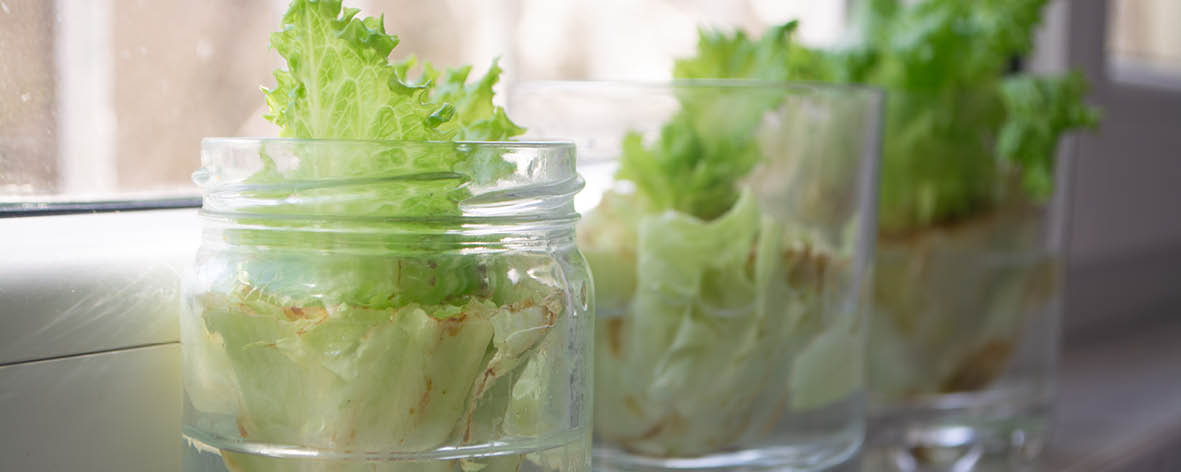Growing your own vegetables from kitchen scraps … our guide

It’s well known that one of the best ways to make a positive impact on the environment (and your wallet) is to grow your own fruit and vegetables, but did you know that you can start your own veggie garden or fruit patch with food scraps? Instead of throwing your potato peels in the compost or de-seeding your capsicums and tossing the seeds away, simply follow our step-by-step guide on how to grow your own fruit and vegetables from kitchen scraps.
1. Lettuce
A staple for summer salads, lettuce is relatively easy to grow from kitchen scraps. Instead of throwing out your leftover leaves, simply place them in a bowl with a small amount of water in the bottom. You’ll want to ensure that you keep the bowl somewhere that gets good sunlight and mist the leaves with water a couple of times each week. After three or four days, you will notice roots beginning to appear along with new leaves. Once this has started to happen, you can transplant your lettuce to soil. Ensure that you give them a good drink after transporting them from the windowsill to your garden. You can grow other vegetables in the same fashion such as bok choy and cabbage.
2. Spring Onions
Spring onions are a tasty addition to so many recipes, delicious in scrambled eggs and the perfect addition to a stir-fry. As delicious as spring onions are, they can be a costly addition to the weekly shop, especially if you don’t plan on using the entire bunch straight away. lLuckily spring onions are one of the best regenerating vegetables, so you can easily reduce food waste with these simple steps. Once you have finished chopping up your spring onion place the left-over white bases and roots into a shallow glass of water in a well-lit area, then sit back and enjoy watching them sprout new green growth. Another great thing about growing your own spring onions from cuttings is that you don’t need plant them in the garden, they are quite happy sitting on your windowsill making them perfect for apartment dwellers.
3. Celery
Celery is one of the easiest foods to grow from leftover scraps. Just cut off the base of your celery and lay it in a bowl with a small amount of warm water in the bottom. Keep the bowl in direct sunlight for as long as possible and after approximately a week, you will notice the leaves beginning to thicken and grow along the base. When this starts to happen, it’s time to transplant your celery into soil and wait for it to grow.
4. Pineapple
Think you need to live in the tropics to grow a pineapple? Think again. All you need to grow your own sweet and delicious tropical fruit is the head of a pineapple, a little patience and somewhere warm to store it as it grows. Just cut the top off your fruit and insert a few toothpicks to hold it above a container filled with water. Keep the container in direct sunlight for as long as possible. If you live somewhere warm it’s perfectly acceptable to sit it outside, on the porch or deck during the day and bring it in at night. It’s important to change the water every other day and keep the container filled so that it nearly reaches the base. You will notice roots in approximately one week and once they are formed you can transplant into potting soil. If you live in a cooler climate, it’s best to grow your pineapple in a pot indoors.
5. Potatoes
Grow your own potatoes from peels. The next time you are peeling spuds for dinner save some peels to plant in your veggie patch, just make sure that the peelings have eyes on them. Cut potato peels into five-centimetre pieces, ensuring that there are at least two or three eyes on each piece. Set them out on some paper towel to dry overnight, then once they are dry to the touch plant them approximately 16 centimetres deep in soil with the eyes are facing upwards. You will need a little patience as it will take a few weeks before you see the potato plant begin to sprout.
6. Capsicum
Done deseeding your capsicum or chilli? Unsure of what to do with all those seeds? Just collect the seeds and plant them in potting mix. Ensure they are kept in direct sunlight unless it is warm outside, if you live in a warmer climate then you can just plant them in your garden. Capsicum grow quite fast and don’t require a lot of care, which is perfect if you need a low maintenance option. Once you get a new crop, you can repeat the process with seeds from your new capsicums.

